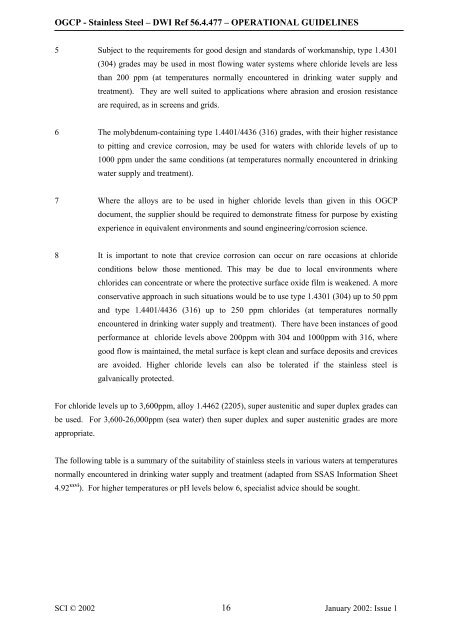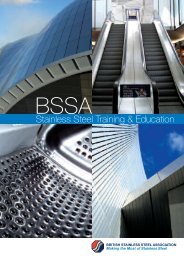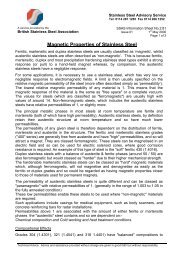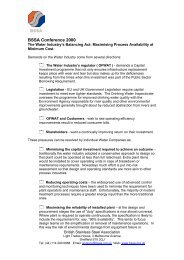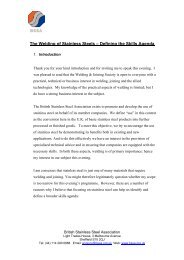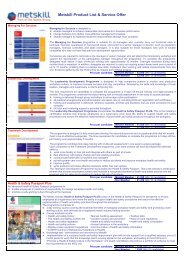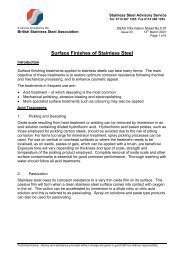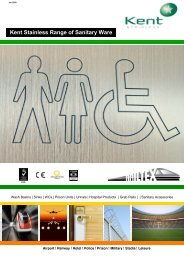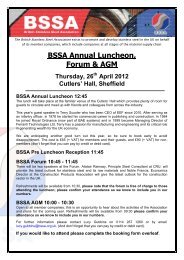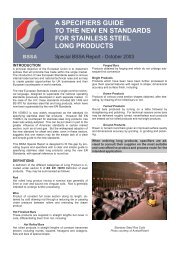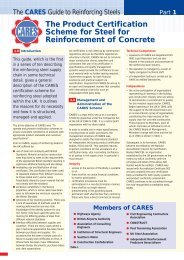Operational guidelines and code of practice for stainless steel
Operational guidelines and code of practice for stainless steel
Operational guidelines and code of practice for stainless steel
Create successful ePaper yourself
Turn your PDF publications into a flip-book with our unique Google optimized e-Paper software.
OGCP - Stainless Steel – DWI Ref 56.4.477 – OPERATIONAL GUIDELINES<br />
5 Subject to the requirements <strong>for</strong> good design <strong>and</strong> st<strong>and</strong>ards <strong>of</strong> workmanship, type 1.4301<br />
(304) grades may be used in most flowing water systems where chloride levels are less<br />
than 200 ppm (at temperatures normally encountered in drinking water supply <strong>and</strong><br />
treatment). They are well suited to applications where abrasion <strong>and</strong> erosion resistance<br />
are required, as in screens <strong>and</strong> grids.<br />
6 The molybdenum-containing type 1.4401/4436 (316) grades, with their higher resistance<br />
to pitting <strong>and</strong> crevice corrosion, may be used <strong>for</strong> waters with chloride levels <strong>of</strong> up to<br />
1000 ppm under the same conditions (at temperatures normally encountered in drinking<br />
water supply <strong>and</strong> treatment).<br />
7 Where the alloys are to be used in higher chloride levels than given in this OGCP<br />
document, the supplier should be required to demonstrate fitness <strong>for</strong> purpose by existing<br />
experience in equivalent environments <strong>and</strong> sound engineering/corrosion science.<br />
8 It is important to note that crevice corrosion can occur on rare occasions at chloride<br />
conditions below those mentioned. This may be due to local environments where<br />
chlorides can concentrate or where the protective surface oxide film is weakened. A more<br />
conservative approach in such situations would be to use type 1.4301 (304) up to 50 ppm<br />
<strong>and</strong> type 1.4401/4436 (316) up to 250 ppm chlorides (at temperatures normally<br />
encountered in drinking water supply <strong>and</strong> treatment). There have been instances <strong>of</strong> good<br />
per<strong>for</strong>mance at chloride levels above 200ppm with 304 <strong>and</strong> 1000ppm with 316, where<br />
good flow is maintained, the metal surface is kept clean <strong>and</strong> surface deposits <strong>and</strong> crevices<br />
are avoided. Higher chloride levels can also be tolerated if the <strong>stainless</strong> <strong>steel</strong> is<br />
galvanically protected.<br />
For chloride levels up to 3,600ppm, alloy 1.4462 (2205), super austenitic <strong>and</strong> super duplex grades can<br />
be used. For 3,600-26,000ppm (sea water) then super duplex <strong>and</strong> super austenitic grades are more<br />
appropriate.<br />
The following table is a summary <strong>of</strong> the suitability <strong>of</strong> <strong>stainless</strong> <strong>steel</strong>s in various waters at temperatures<br />
normally encountered in drinking water supply <strong>and</strong> treatment (adapted from SSAS In<strong>for</strong>mation Sheet<br />
4.92 xxvi ). For higher temperatures or pH levels below 6, specialist advice should be sought.<br />
SCI © 2002 16<br />
January 2002: Issue 1


